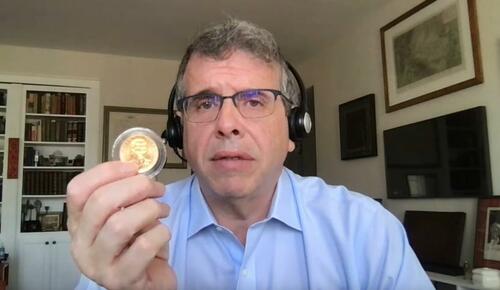Why Nick Colas Is Bullish On Gold
Nick Colas is bullish on gold.
The former Credit Suisse analyst and SAC Capital portfolio manager who founded DataTrek Research in 2017 has started offering his thoughts via YouTube, where he's opined on topics such as his 3 cardinal rules of investing, how to use the VIX to trade smarter, and the best way to value Tesla.
On Tuesday, Colas discussed where he thinks gold is headed...
In 1960, Colas's family came to America just after the Cuban revolution with $200 in a suitcase. After scrambling to land on their feet, his father began buying gold coins on business trips to Europe when it was $35 to $37 an ounce.
"He viewed gold as a long-term store of value," Colas said of his father. Then, "in 1971 President Nixon took the U.S. dollar off the gold standard and prices began to rise."
"In the late 70s inflation really took over as a big investment theme and the price of gold was going up even further," he continues.
In 1974, gold soared from its $35 valuation in the 1960s to $600 an ounce by 1980.
Gold vs. Equities: The Unspoken Truth
While the S&P 500 has grown roughly 13% per year over the last decade, when one looks outside US borders, gold's 5% annual compounded growth begins to look quite impressive. Colas notes that the MSCI All-Country Ex-U.S. index and Chinese equities have shown a mere 5% and 3% growth, respectively. So if your portfolio isn't U.S.-centric, gold not just holds its own but shines.
The crux of the argument: Central Banks love it!
According to the World Gold Council, 25% of the demand for gold has come from central banks - primarily China, Russia, Turkey, and India. Why? For strarters, gold is priced in dollars, still the world's reserve currency.
"Owning gold is like owning the Dollar Plus the volatility of the underlying assets," explains Nicholas.
Gold also offers central banks immunity to sanctions and confiscation during geopolitical upheavals. With increasing tensions involving countries like Russia and China, central banks are moving towards assets that aren't just backed by the dollar but also impervious to sanctions and confiscations, such as what we saw with Russian assets following the invasion of Ukraine.
In short: "We're pretty bullish on gold for the next five to ten years you have good underlying demand good incremental demand from central banks."
Watch:



